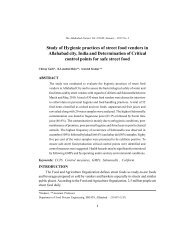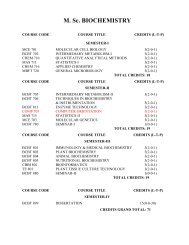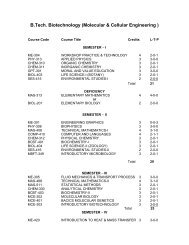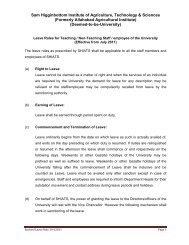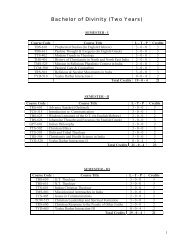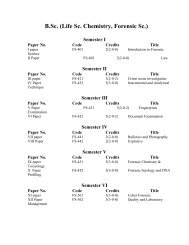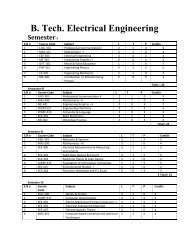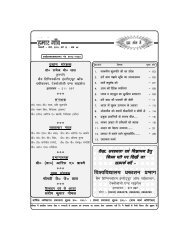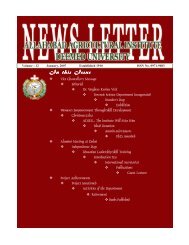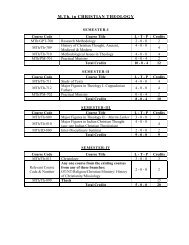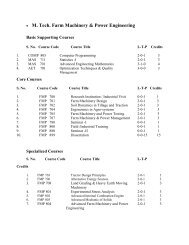B. Tech. Production & Industrial Engineering - Shiats.edu.in
B. Tech. Production & Industrial Engineering - Shiats.edu.in
B. Tech. Production & Industrial Engineering - Shiats.edu.in
Create successful ePaper yourself
Turn your PDF publications into a flip-book with our unique Google optimized e-Paper software.
Signals System and actuat<strong>in</strong>g devices; real time <strong>in</strong>terfac<strong>in</strong>g. Applications of? Mechatronics <strong>in</strong> Manufactur<strong>in</strong>gand Automation Case Studies.METAL FORMING1- Fundaments of Elasticity, Plasticity and Viscoplastcity, Stress and stra<strong>in</strong> <strong>in</strong>variant?Elesticity- State?? of stress and stra<strong>in</strong>, stress-stra<strong>in</strong> relations,? stra<strong>in</strong>-displacement relations.Plasticity and Viscoplasticity: Yeld?? criterian, effective stress and stra<strong>in</strong>, state of plastic stra<strong>in</strong>,Plastic stra<strong>in</strong> rate, Flow rule, Effective stra<strong>in</strong> rate, plastic anisotropy and viscoplasticity(determ<strong>in</strong>ation of load and power) concept of solid and flow formulations.?2- Analysiz of Deformation Processes us<strong>in</strong>g SSM, UBM & SLMPla<strong>in</strong> stra<strong>in</strong> Problems: Draw<strong>in</strong>g and Extrusion of sheet, Roll<strong>in</strong>g and forg<strong>in</strong>g of strips.Axisymmetric?? Problems: Draw<strong>in</strong>g and Extrusion of bar and tube, forg<strong>in</strong>g of solid and Hallowdisc.Sheet metal problems: Axisymmetric deep draw<strong>in</strong>g and stretch<strong>in</strong>g.ENERGY CONSERVATIONCourse Code ME-674 CREDIT : 3(3-0-0)1.Introduction: The energy crisis and options: the energy conservation option, energy <strong>in</strong>tensity ofdeveloped and develop<strong>in</strong>g economies, energy audit<strong>in</strong>g ? basic requirements, scope and purpose,process energy and gross energy requirements.2.Efficient energy conversion: efficient combustion, waste as a fuel, comb<strong>in</strong>ed cycles for efficientpower generation, comb<strong>in</strong>ed heat and power plants, comb<strong>in</strong>ed cool<strong>in</strong>g and power plants.3. Energy recovery: <strong>in</strong>sulation: <strong>in</strong>sulat<strong>in</strong>g materials, economic thickness of <strong>in</strong>sulation; heat recoveryheat exchangers: recuperative heat exchangers, run-around coil systems, regenerative heat exchangers;heat pumps; and heat-pipes.4. Process <strong>in</strong>tegration: basic concepts of p<strong>in</strong>ch technology, stream networks, significance of the p<strong>in</strong>ch,design of energy recovery system.5. Energy conservation <strong>in</strong> build<strong>in</strong>gs: degree-days, steady state loads and comfort. Condition<strong>in</strong>g the airfor process requirements and human comfort, thermal performance monitor<strong>in</strong>g, efficient light<strong>in</strong>gsystems, solar passive features.6. Economics of energy sav<strong>in</strong>g schemes and case studies.REFERENCES(A) Energy efficiency? by Eastop and Croft, Longman Scientific and <strong>Tech</strong>nical, 1990(B) Manag<strong>in</strong>g energy <strong>in</strong> commerce and <strong>in</strong>dustry? by Gordon A Payne, Butterworths, 1984.CAD OF THERMAL SYSTEMSCourse Code ME-675 CREDIT : 3 (3-0-0)



